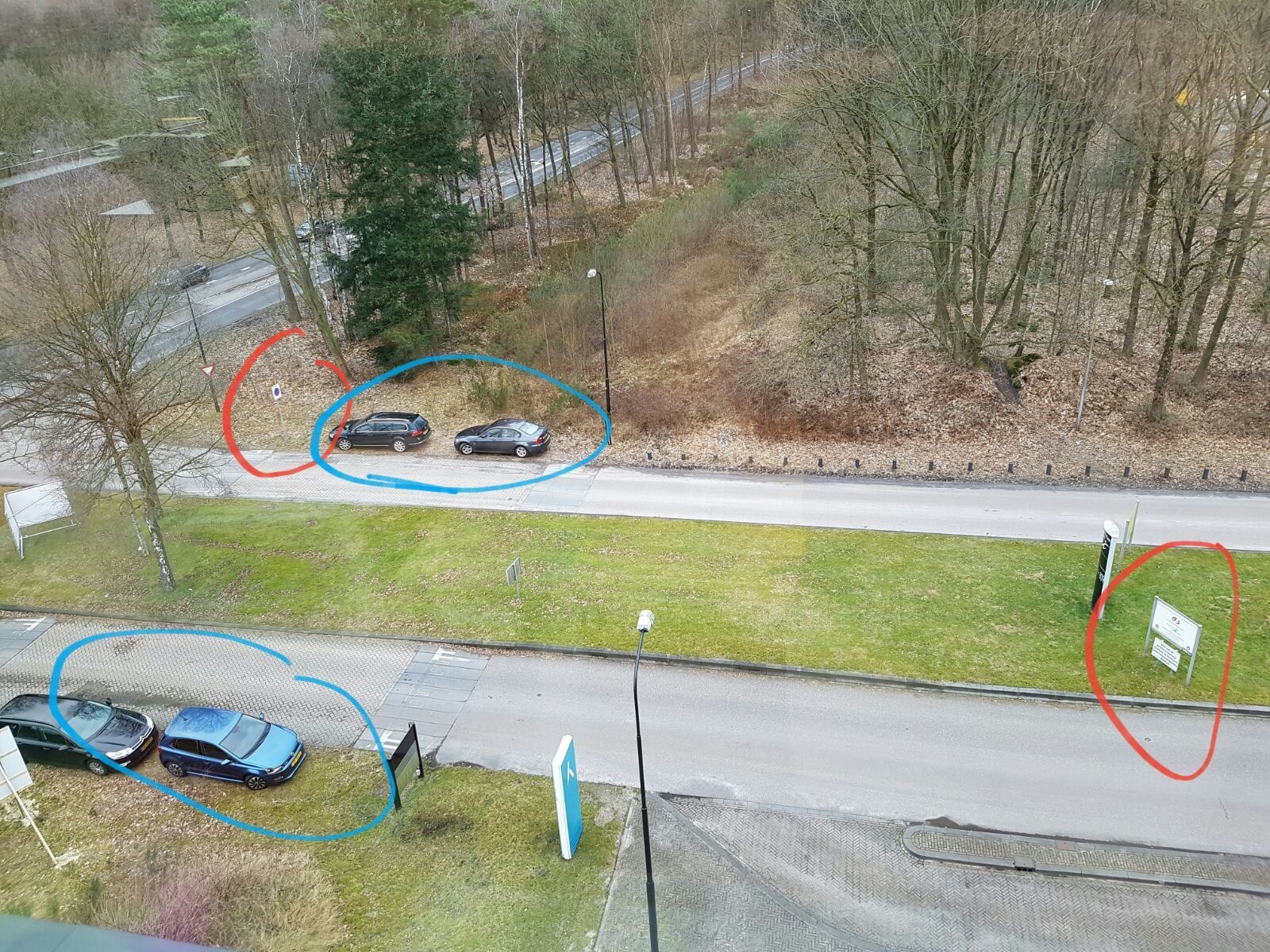Zoals dfrenner al zei is er op 23 mei 2016 een uitspraak (ECLI:NL:RBNHO:2013:10952) geweest van het gerechtshof in Arnhem in een hoger beroep over een soortgelijke kwestie. Interessante link:
https://www.verkeersnet.nl/20086/mag-je-hier-parkeren/, met als onderbouwing (mede) een eerdere uitspraak uit 2013 en het Verdrag van Wenen. Feitelijk gaan de bepalingen in het Verdrag van Wenen voor die van onze Wegenverkeerswetgeving.
Uit het Verdrag:
Article 1. Definitions
For the purpose of this Convention, the following expressions shall have the meanings hereby assigned to them:
(…)
c) "Road" means the entire surface of any way or street open to public traffic;
( d) "Carriageway" means the part of a road normally used by vehicular traffic; a road may comprise several carriageways clearly separated from one another by, for example, a dividing strip or a difference of level;
( e) "Lane" means any one of the longitudinal strips into which the carriageway is divisible, whether or not defined by longitudinal road markings, which is wide enough for one moving line of motor vehicles other than motor cycles (…)."
"Article 6
1.
Signs shall be so placed that the drivers for whom they are intended can recognize them easily and in time. They shall normally be placed on the side of the road appropriate to the direction of traffic; they may, however, be placed or repeated above the carriage-way. Any sign placed on the side of the road appropriate to the direction of traffic shall be repeated above or on the other side of the carriageway if local conditions are such that it might not be seen in time by the drivers for whom it is intended.
2.
All signs shall apply to the drivers for whom they are intended over the whole width of the carriageway open to traffic. However, signs may be made to apply to only one or to several lanes of the carriageway when lanes are defined by longitudinal markings.
In this case, one of the following three options shall be used:
a. a) The sign with, if necessary, the addition of a vertical arrow shall be placed above the lane concerned, or
b) The sign will be placed on the nearside edge of the carriageway when the road markings indicate without doubt that the sign applies solely to the traffic lane on the nearside of the carriageway and that the only purpose of this sign is to confirm a local regulation already indicated by means of road markings, or
c) Signs E, 1 or E, 2 described in Annex 1, section E, subsection II, paragraphs 1 and 2 to this Convention or signs G, 11 and G, 12 described in Annex 1, section G, subsection V, paragraphs 1 and 2 will be placed on the edge of the carriageway."
Daarbij komt nog dat de berm volgens artikel 10 van het RVV gebruikt mag worden om te parkeren; eventuele ingestelde parkeerverboden gelden alleen voor de rijbaan.
Op de rijbaan parkeren kan hier sowieso niet, dan veroorzaak je hinder en kun je op basis van artikel 5 (Wegenverkeerswet) beboet worden. Buiten de bebouwde kom (voor zover het voorrangswegen betreft) mag je niet op de rijbaan parkeren, dat is vanwege verkeersonveiligheid geregeld in artikel 24, lid 1 onderdeel c.
Met betrekking tot de APV, volgens mij is het zo dat als het in de wet staat, het niet nodig / wenselijk is het alsnog in de APV op te nemen.
[
Voor 64% gewijzigd door
Crazz op 28-02-2017 13:34
]


/u/421470/crop5851203431803_cropped.png?f=community)
/u/33305/crop60893dfd18ede_cropped.png?f=community)
:strip_icc():strip_exif()/u/2646/shine.jpg?f=community)
:strip_icc():strip_exif()/u/52072/crop5de51ebf91960_cropped.jpeg?f=community)
:strip_icc():strip_exif()/u/148505/31bb5b263ef71bb4d5751e9a89035105.jpeg.jpg?f=community)
:strip_icc():strip_exif()/u/171690/crop5db00e7903620_cropped.jpeg?f=community)
:strip_icc():strip_exif()/u/732481/crop5b5d37f8199f6_cropped.jpeg?f=community)
:strip_icc():strip_exif()/u/337792/tandemlarge%2520-%2520Copy.jpeg?f=community)
:strip_exif()/u/707155/crop594cfeb4a17c8_cropped.gif?f=community)
:strip_icc():strip_exif()/u/142351/IT_crowd60.jpg?f=community)
:strip_exif()/u/310429/gif_70x53_c2f20f.gif?f=community)
:strip_icc():strip_exif()/u/343613/crop5a6b35a6ef62a_cropped.jpeg?f=community)
/u/189860/crop5cd57bf8c14b3_cropped.png?f=community)

:strip_icc():strip_exif()/u/226826/aardblij-60.jpg?f=community)
:strip_icc():strip_exif()/u/52016/Alfa-TiMo-square-60.jpg?f=community)
/u/465331/MeControlXXLUserTile2.png?f=community)
:strip_icc():strip_exif()/u/295699/crop609bc9a510a14_cropped.jpg?f=community)
:strip_icc():strip_exif()/u/46872/volume-s.jpg?f=community)
/u/32368/crop694538950f5e0_cropped.png?f=community)